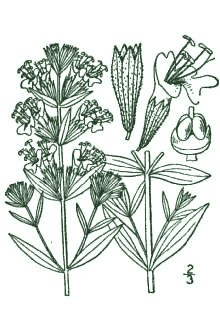Hyssop History – Name and Species Origins
(Hyssopus officinalis, Linn.)

The name comes from the Greek word hyssopos and the Hebrew word for Azob, a holy herb, used for cleaning sacred places.
Hyssop is a native of southern Europe and the Mediterranean. It is not clear when hyssop was brought to England. It may have been as early as the 13th Century as it has become naturalized on the wall of Beaulieu Abbey, which was founded in 1203 or 1204. The cultivation of ‘Ysope’ is described in the Feate of Gardening which dates to before 1440.
Turner (1508 – 1568), often referred to as the Father of British Botany, makes mention of a second variety that is all ‘roughe and hory’ and is much more hardy than common hyssop.
Gerard, author of Herball or Historie of Plants(1597), appears to have grown both varieties and considered common hyssop quite ordinary and common, declining to include it in his works as it was so well-known.
Tudor and Elizabethan knot-gardens often included hyssop. During this period, it was still common for floors to be strewn with rushes and sweet herbs and hyssop’s sweet scent made it quite useful for that purpose.
Hyssop History – Biblical Hyssop.
Much has been written about the Biblical references to hyssop and much of the conversation surrounds the debate whether or not the hyssop of the Bible is the same plant we are discussing here.
What is certain – Biblical hyssop was used along with other aromatic plants including marjoram, thyme and mint. They were used to purify sin and cleanse the soul. The herbs were often waved like a wand after being dipped in the water of purification or vinegar. Much of the disagreement as to whether or not Biblical hyssop is actually hyssopus officinalis centers around the origins of the plant and if its stems were actually long enough and strong enough to match the plant described in the Bible.
In the Bible, lepers were treated or perhaps simply cleansed with hyssop. The hyssop was said to be dipped in the blood of a living bird and a sacrificial bird, wrapped with scarlet wool and attached to a stick or wand of cedar wood.
Scholars throughout the centuries have explored if Biblical hyssop was indeed hyssopus officinalus. Celcius wrote extensively in his Herbal about the numerous varieties of hyssop. Capporis spinosa, or common caper is one often considered. Other Biblical hyssop candidates have included marjoram, thyme, mint and sage.
Biblical hyssop was used to cleanse the sinful and was used, some say for the last time, during the burial of Jesus, who died for all of our sins.
Hyssop History – Folklore
Most of what has been written about this history of hyssop refers to the Bible. However, we did find a reference that mentioned using hyssop to provide protection from the evil eye and as a guard against witches. Perhaps, even this refers to the perceived cleansing properties mentioned in the Bible.
Hyssop history also refers to the white or yellow stripes and fragrance led to hyssop often being planted on graves but unfortunately does not explain why.
Hyssop History – Early Medicinal Uses
Early physicians often relied on hyysop. Hyssop vapors were considered by Turner to be useful to “driveth away the winde that is in the eares, if they be holden over it.” And Parkinson (1567 – 1650) in Paradisi in Sole, Paradisus Terrestris claimed “it is many countrey people’s medecine for a cut or greene wound, being bruised with sugar and applied.” He also recommended a decoction of hyssop would “taketh away the itching and tingling of the head, and vermin also breeding therein.”
Hyssop History – Modern Medicinal Uses
Hyssop is often used in an infusion to aid digestion, ease coughs, sore throats, hoarseness and bronchial catarrh. An old country remedy that continues to be used is hyssop tea and hyssop baths to ease rheumatism, bruises and discolored contusions. In a lotion form, hyssop is used to treat ear, eye and throat infections and to relieve bites and stings.
Hyssop is considered an emmenagogue, something that stimulates blood flow in the pelvic area and is often used to stimulate menstrual flow. One of our references recommends that pregnant woman avoid hyssop due to this property.
One source recommends not using hyssop oil, internally or externally, because it causes muscle spasms and even epileptic seizures but another says that in careful doses the oil is not harmful. Both of those sources said, that in small amounts, the leaves and flowers are safe. Only a few drop of hyssop oil can lead to convulsions in children. Please do more research before using hyssop as anything other than an ornamental herb.
Additional Hyssop Information.
Our Herb Garden also has guides on Growing Hyssop and Hyssop Companion Planting.